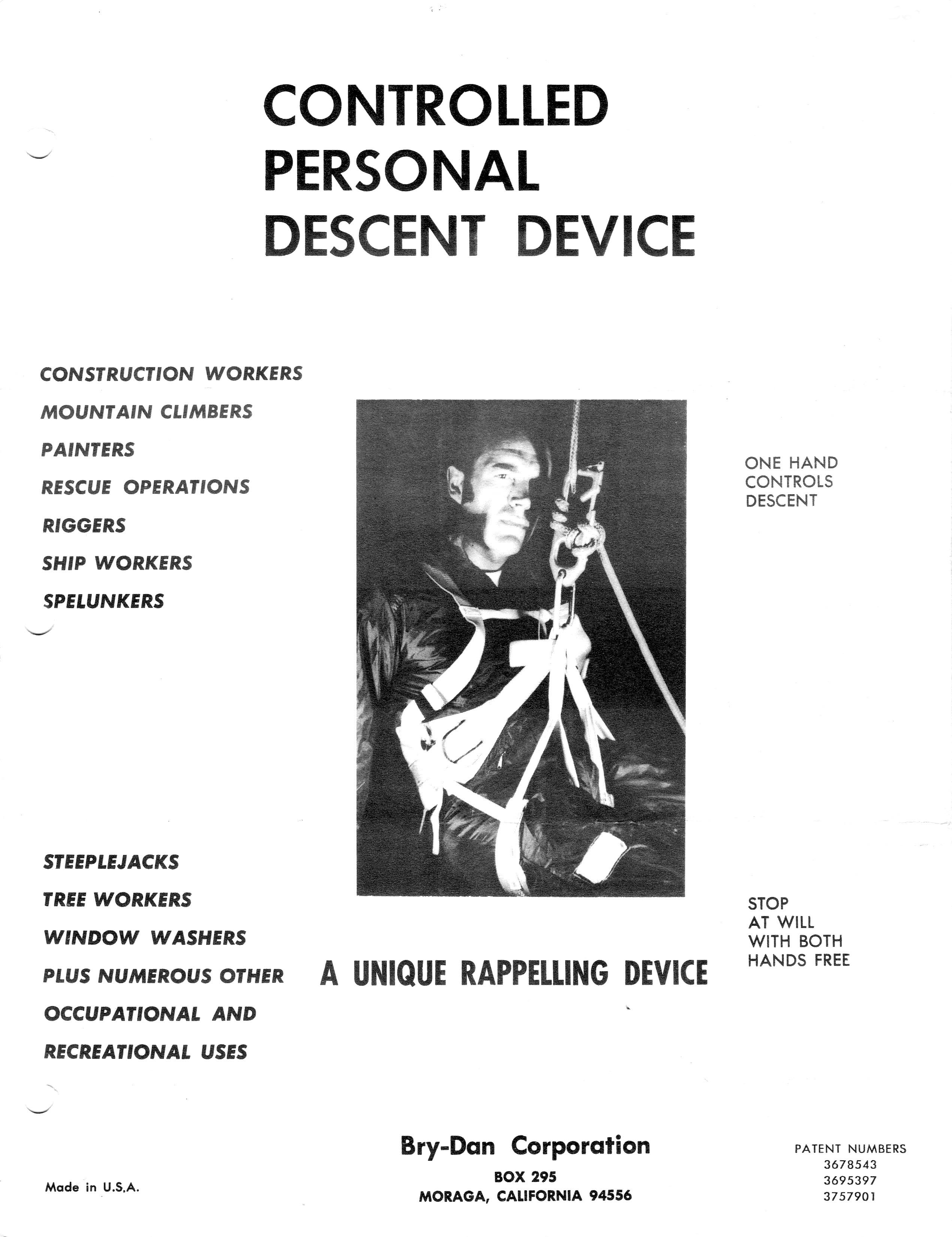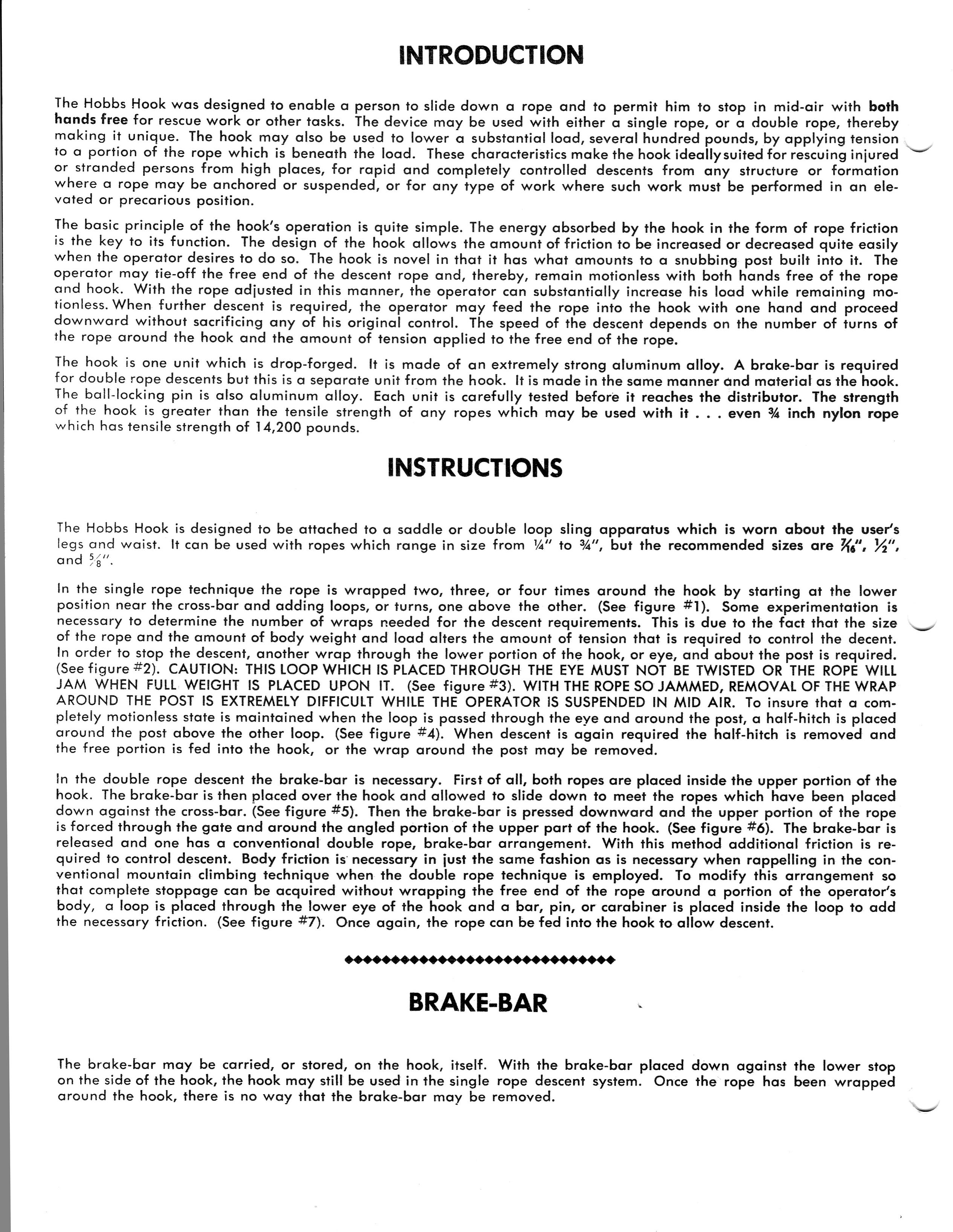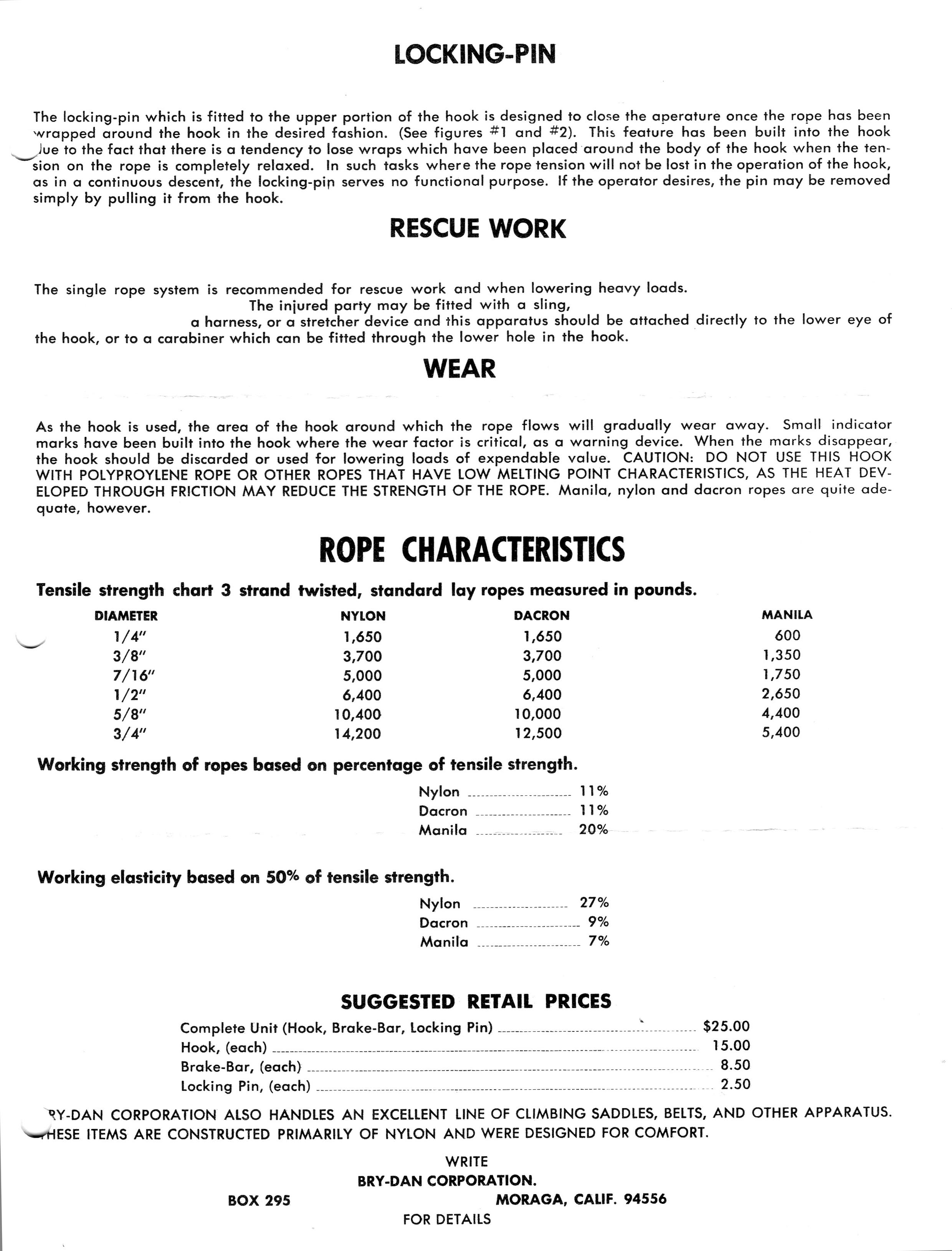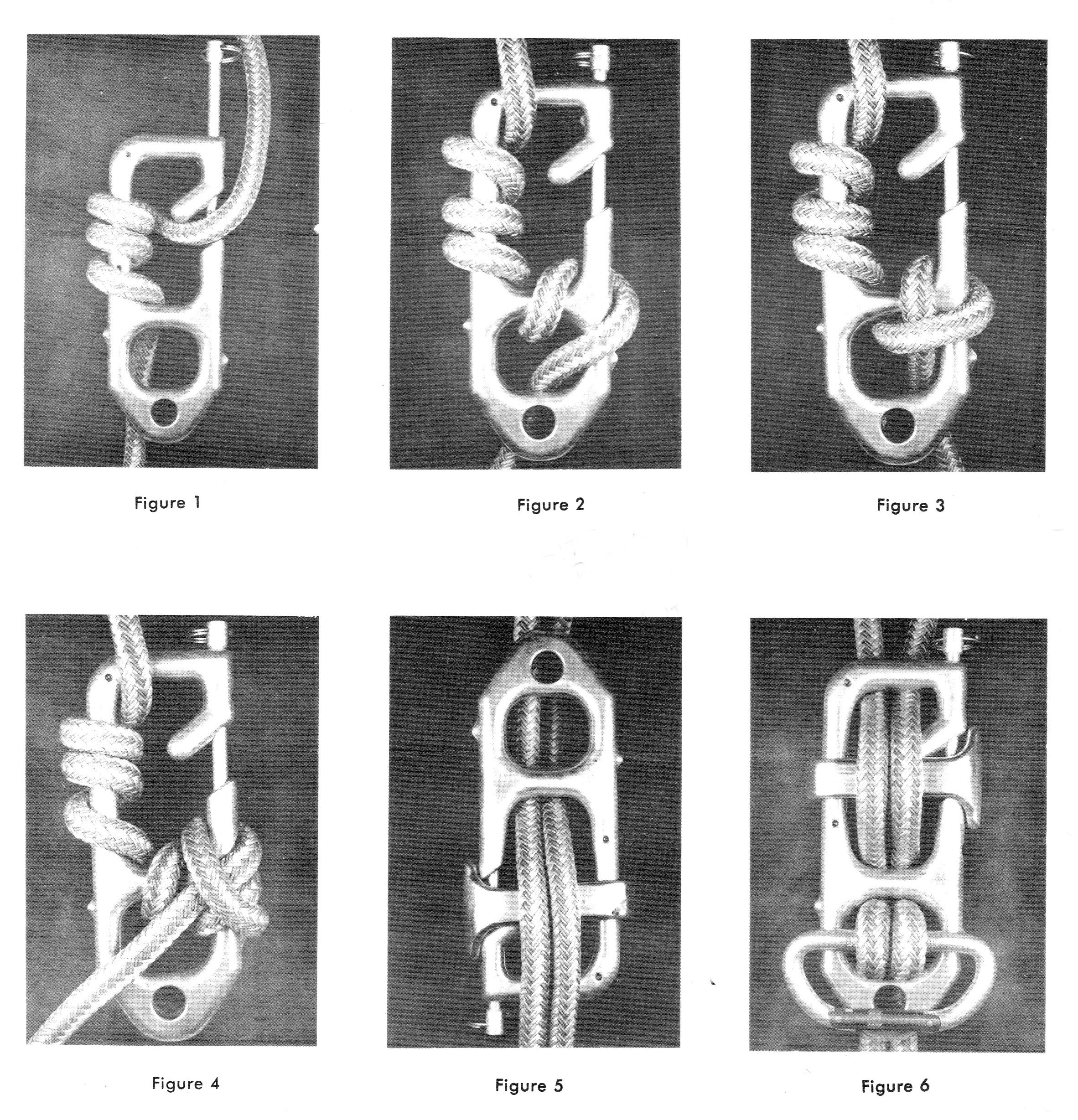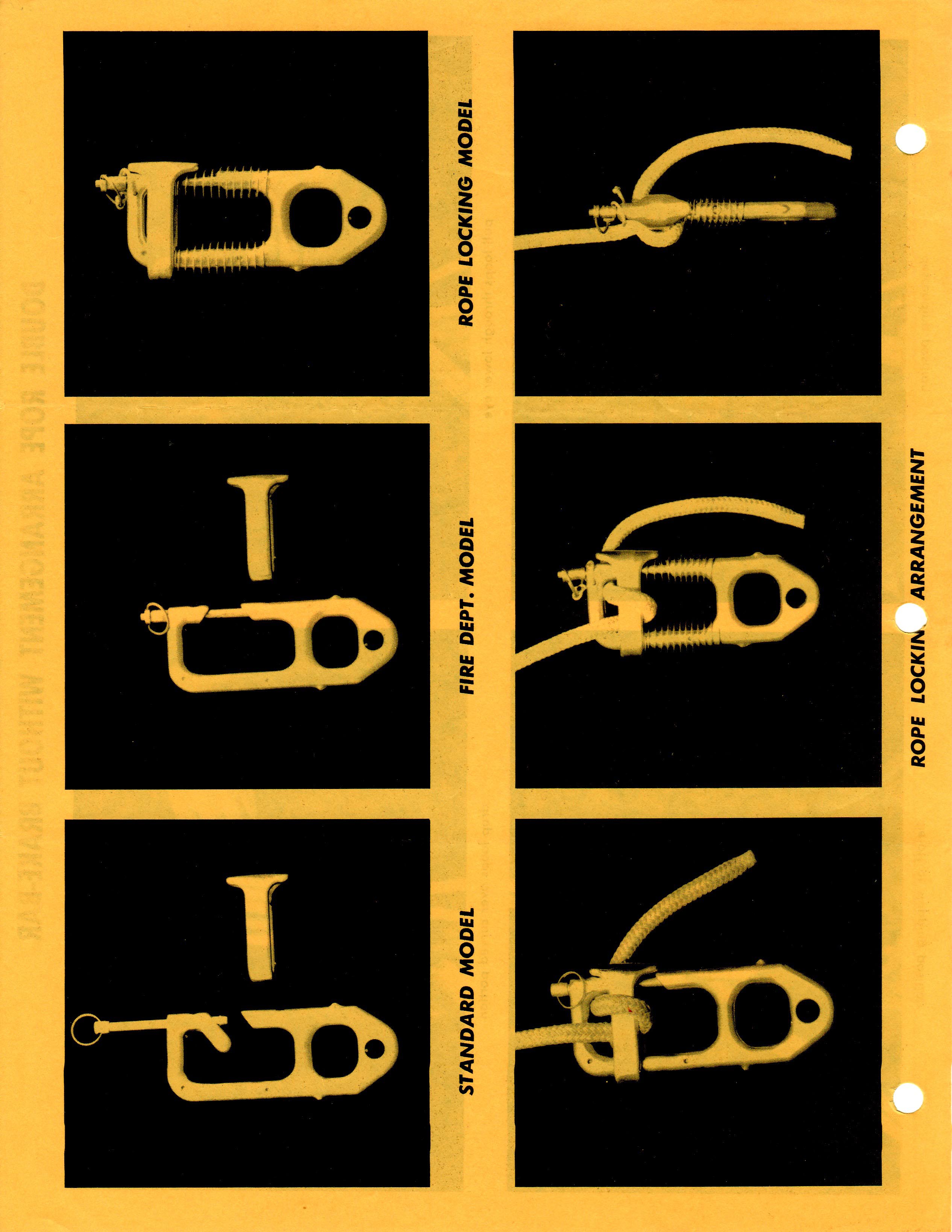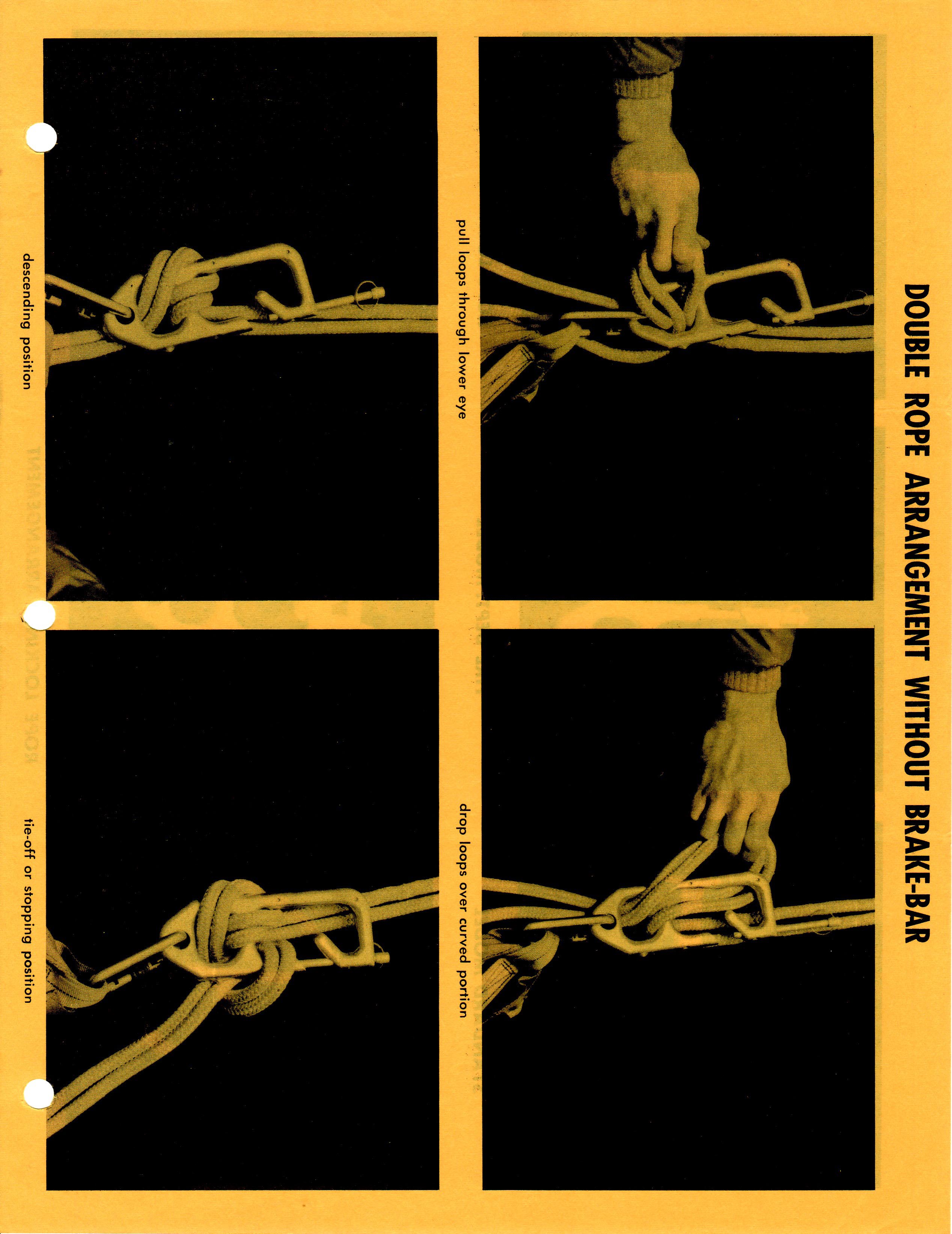Overview
[ Top
| Fire Dept.
| Return
to Hooks
]
Standard Model
(#360, 3341)
Technical Details
I acquired this descender from the manufacturer in the mid-1970s,
probably about 1976. I bought another (missing the brake bar) from David Crown on eBay in 2023.
There are three models of Hobbs Hook illustrated in the brochure
that accompanied the one that I bought. I have one of the standard
models, consisting of three pieces. The main body is an aluminum
and is 195 mm. long, 76 mm. wide, and 16 mm. thick. It is roughly
pentagonal, with parallel sides and a pointed bottom. The upper
two-thirds has an irregular cutout opening to the side of the
device. Below this is a 44 mm. wide by 38 mm. high rounded rectangular
hole. Finally, a 12.7 mm. hole at the bottom provides an attachment
point. Two pips on the side are used to limit the motion of the
optional brake bar described below. Two dimples in the device
serve as wear monitor points. The entire frame is well-rounded
except for the tie-in hole, which is beveled. A hole in the top
of the frame extends down the open side and across the side opening.
A 116 mm. long, 7.9 mm. diameter aluminum spring-ball pin fits
into this hole and acts as a safety to keep the rope in the device.
A hole in the side of the short leg of the frame lets the pin
balls expand to lock the pin in place, provided the pin is turned
properly. A hole in the top of this pin accepts a 25 mm. wire
ring that serves as a finger hold for removing the pin. My pin
is marked "AVDEL 52133" which is undoubtedly a part
number. The third piece is the optional brake bar assembly. In
top view it is oval with a 17.5 by 79 mm. hole sized so that the
bar can slide over the top of the main frame. Its outside dimensions
are 93 mm. wide and 31 mm. thick. It is 21. 5 mm. high for most
of its width, with extensions at the top and bottom of one end
increasing the total height to 55 mm. These extensions are large
enough to bridge the opening in the side of the main frame. The
brake bar is stamped in ink with "3 707516" and "Brake Bar."
The main frame weighs 288 g, the pin and ring 19 g., and the bar
87 g, for a total of 394 g.
The device is covered by U.S. Patents 3,678,543,
3,695,397, and 3,757,901.
The Hobbs Hook can be used in several ways. The factory literature
recommends three principal configurations: a wrap, a brake bar
configuration, and a double rope configuration reminiscent of
the the Longhorn.

 The
wrap configuration allows incrementally variable friction. I prefer
to use two wraps. The wrap direction is not important for kernmantle
ropes. On laid ropes, the wrap should be made in the same direction
as the rope (i.e., right-hand for right-hand ropes) so that the
device does not tend to unravel the rope. It is possible to add
or delete wraps on rappel, but it is difficult to do so and I
do not recommend attempting it. Like most wrap devices, the Hobbs
Hook in the wrap configuration introduces considerable spin on
free drops. The rappel can be tied off by passing a bight of the
trailing line through the rectangular hole and over the lower
horn. The
brake bar configuration avoids the spin of the wrap configuration,
but requires an additional piece of equipment. The tall side of
the brake bar should be on the open side of the device so that
it spans the opening. Friction can be enhanced by passing a bight
through the rectangular hole, clipping a spare carabiner through
the bight, and arranging the carabiner as a second brake bar.
The brake bar arrangement cannot be locked off in the same manner
as the wrap configuration because the brake bar spans the opening.
I've found that the device can be locked off by looping the trailing
line over the top of the device; however, this method is not as
secure as the lock-off used for the wrap. An alternate is to pass
a bight through the rectangular hole and tie it off in any of
a number of ways. This method can be secure, but is invariably
cumbersome.
The
wrap configuration allows incrementally variable friction. I prefer
to use two wraps. The wrap direction is not important for kernmantle
ropes. On laid ropes, the wrap should be made in the same direction
as the rope (i.e., right-hand for right-hand ropes) so that the
device does not tend to unravel the rope. It is possible to add
or delete wraps on rappel, but it is difficult to do so and I
do not recommend attempting it. Like most wrap devices, the Hobbs
Hook in the wrap configuration introduces considerable spin on
free drops. The rappel can be tied off by passing a bight of the
trailing line through the rectangular hole and over the lower
horn. The
brake bar configuration avoids the spin of the wrap configuration,
but requires an additional piece of equipment. The tall side of
the brake bar should be on the open side of the device so that
it spans the opening. Friction can be enhanced by passing a bight
through the rectangular hole, clipping a spare carabiner through
the bight, and arranging the carabiner as a second brake bar.
The brake bar arrangement cannot be locked off in the same manner
as the wrap configuration because the brake bar spans the opening.
I've found that the device can be locked off by looping the trailing
line over the top of the device; however, this method is not as
secure as the lock-off used for the wrap. An alternate is to pass
a bight through the rectangular hole and tie it off in any of
a number of ways. This method can be secure, but is invariably
cumbersome.

 The double rope configuration has less spin than the wrap configuration,
yet does not require the brake bar. Note that the bight is placed
around the long side of the frame rather than the short horn.
This increases security and leaves the short horn available for
tying off.
The double rope configuration has less spin than the wrap configuration,
yet does not require the brake bar. Note that the bight is placed
around the long side of the frame rather than the short horn.
This increases security and leaves the short horn available for
tying off.
There are many variations to the three configurations recommended
by the manufacturer, none of which seem to offer any substantial
advantages.
The Hobbs hook is well made. There are no sharp edges and all
edges are well-rounded, except for the beveled attachment hole.
The pin is long enough that there does not seem to be any tendency
for it to back out, even if it is not turned to allow the balls
to engage properly. In any case, the pin does not support any
load, nor does it touch the rope. The pin is almost optional in
the wrap and brake bar configurations, except when negotiation
the pit lip. The wear monitor points are located in a position
where the rope does not usually run over them, so they do not
function as well as they could. They also seem to be to deep for
my taste, and I would retire a Hobbs Hook long before the wear
marks indicated that I needed to.
The manufacturer warns the user not to use the device with
polypropylene rope or other ropes having a low melting point.
Bry-Dan recommends 11 mm. to 16 mm. nylon rope, but notes that the
device will work with 6.4 to 19 mm. rope.
[ Top
| Standard
| Return
to Hooks
]
 Fire Dept. Model
Fire Dept. Model
(#1198, 3342)
Technical Details
I acquired my Bry-Dan Hobbs, Fire Dept. Model from Ken Laidlaw in 2009. Ken bought it from the manufacturer in the 1970s. I bought another (missing the brake bar) from David Crown on eBay in 2023.
This Bry-Dan Hobbs, Fire Dept. Model is 225 mm. tall, 93 mm. wide, 31 mm. thick, and weighs 399 g. The frame looks like it was made by cutting the inner hook off of a standard model, and then drilling two more holes from the side for the balls on the pin. The pin is a push-button quick-release pin that is shorter than the pin on the standard model. The brake bar is essentially the same as the standard model brake bar.
There are no markings on the frame. The brake bar is printed with "62296-1 7075T6" and "BRAKE BAR." The pin is stamped with "LOCKWELL," "PUSH," and "LC 5 S R 3300."
The workmanship in cutting the inner hook off is crude: it looks like it was done with hand tools in someone’s garage, but when I asked Ken about this, he told me that this is how it arrived from the factory. I also note that they had some severe chatter when countersinking the eye.
The opening in the frame is too long to support the brake bar, which tends to drop down onto the QR pin. I looked at the photographs that came with my standard model, and although the opening on this Hobbs is longer than the one in the pictures, the one in the pictures is too long to support the brake bar as well. That makes this a lemon in my book  .
.
[ Top
| Standard
| Fire Dept.
]




 The
wrap configuration allows incrementally variable friction. I prefer
to use two wraps. The wrap direction is not important for kernmantle
ropes. On laid ropes, the wrap should be made in the same direction
as the rope (i.e., right-hand for right-hand ropes) so that the
device does not tend to unravel the rope. It is possible to add
or delete wraps on rappel, but it is difficult to do so and I
do not recommend attempting it. Like most wrap devices, the Hobbs
Hook in the wrap configuration introduces considerable spin on
free drops. The rappel can be tied off by passing a bight of the
trailing line through the rectangular hole and over the lower
horn. The
brake bar configuration avoids the spin of the wrap configuration,
but requires an additional piece of equipment. The tall side of
the brake bar should be on the open side of the device so that
it spans the opening. Friction can be enhanced by passing a bight
through the rectangular hole, clipping a spare carabiner through
the bight, and arranging the carabiner as a second brake bar.
The brake bar arrangement cannot be locked off in the same manner
as the wrap configuration because the brake bar spans the opening.
I've found that the device can be locked off by looping the trailing
line over the top of the device; however, this method is not as
secure as the lock-off used for the wrap. An alternate is to pass
a bight through the rectangular hole and tie it off in any of
a number of ways. This method can be secure, but is invariably
cumbersome.
The
wrap configuration allows incrementally variable friction. I prefer
to use two wraps. The wrap direction is not important for kernmantle
ropes. On laid ropes, the wrap should be made in the same direction
as the rope (i.e., right-hand for right-hand ropes) so that the
device does not tend to unravel the rope. It is possible to add
or delete wraps on rappel, but it is difficult to do so and I
do not recommend attempting it. Like most wrap devices, the Hobbs
Hook in the wrap configuration introduces considerable spin on
free drops. The rappel can be tied off by passing a bight of the
trailing line through the rectangular hole and over the lower
horn. The
brake bar configuration avoids the spin of the wrap configuration,
but requires an additional piece of equipment. The tall side of
the brake bar should be on the open side of the device so that
it spans the opening. Friction can be enhanced by passing a bight
through the rectangular hole, clipping a spare carabiner through
the bight, and arranging the carabiner as a second brake bar.
The brake bar arrangement cannot be locked off in the same manner
as the wrap configuration because the brake bar spans the opening.
I've found that the device can be locked off by looping the trailing
line over the top of the device; however, this method is not as
secure as the lock-off used for the wrap. An alternate is to pass
a bight through the rectangular hole and tie it off in any of
a number of ways. This method can be secure, but is invariably
cumbersome.
 The double rope configuration has less spin than the wrap configuration,
yet does not require the brake bar. Note that the bight is placed
around the long side of the frame rather than the short horn.
This increases security and leaves the short horn available for
tying off.
The double rope configuration has less spin than the wrap configuration,
yet does not require the brake bar. Note that the bight is placed
around the long side of the frame rather than the short horn.
This increases security and leaves the short horn available for
tying off.